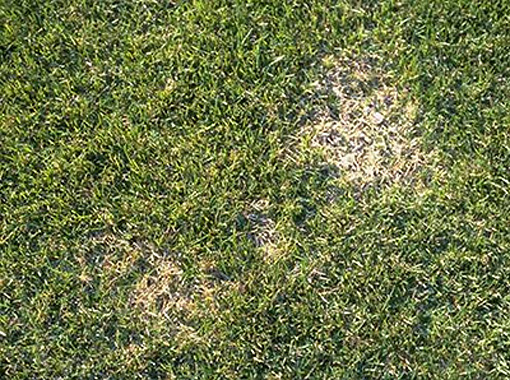The combination of hot, humid weather and hot dry spells has created the perfect conditions for two prominent lawn problems this summer. Our maintenance crews have reported sightings of both brown patch and sod webworm. In this article, we discuss their symptoms, causes and treatment.
Brown Patch

Brown patch on tall fescue. Irregular patches can range from several inches to several feet in diameter.
Brown patches are appearing in lawns. The brown patches are yellow-tan to brown in color, and range from a few inches to several feet in diameter as summer continues. White fungus can also appear on grass blades during dewy, damp periods.
These are symptoms of brown patch, a turfgrass disease caused by the fungus Rhizoctonia solani. This disease breaks out during hot and humid weather, when temperatures during the day are in the 80s and 90s, and above 65 degrees at night. All cool-season turfgrass species are affected, and damage is more severe in overwatered, overfertilized lawns. Badly affected grass areas can rot and die.

An affected blade of tall fescue with lesions. Lesions have tan centers with dark, jagged margins. Photo credit: University of Illinois.
Treatment and Control
A light infection of brown patch may recover on its own in a few weeks. In lawns with severe infections, strip and remove the dead grass and re-seed.
Water your lawn and landscape early in the morning to allow foliage to dry. Avoid watering at night and overwatering
Do not fertilize your lawn during hot and humid weather.
Nature’s Perspective treats and controls brown patch in lawns with fungicide applications.
Sod Webworm
If you have a lawn that has not been regularly watered and is turning dormant, you may see light brown, thatchy patches in your lawn up to 3-4 inches in diameter. You may also see birds pecking in these patches for something to eat, leaving small holes. Moist green pellets may also be found in these thatchy patches (these pellets are actually poop!).
These are the symptoms of sod webworm damage, caused by the larvae of sod webworm moths. Also called lawn moths, you may find these 3/4-inch pale beige insects with snoutlike horns flying over grass at dusk. The larvae eat grass leaves and stems just above the crown from July to August, and again in September.
Sod webworm larvae are susceptible to a disease caused by the fungus microsporidia, which naturally thrive in moist conditions, so they are normally killed when lawns are irrigated or after it rains. When drought conditions arise, and lawns are left unwatered and turn dormant, sod webworm becomes problematic.
Treatment and Control
Use endophyte-treated grass seed. Endophytes are beneficial fungi that live between the cell walls of grass plants, and the alkaloid they produce helps the plant resist insects and diseases.
During drought conditions, keep your lawn irrigated by watering early in the morning.
Organic treatment methods to suppress sod webworm populations are insect-parasitic nematodes and the bacterium Bacillus.
Nature’s Perspective Landscaping controls sod webworm with insecticide when the symptoms arise.
For a correct diagnosis of your lawn issues and treatment options, please call our office.

